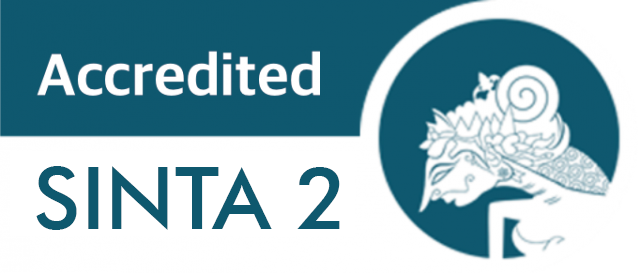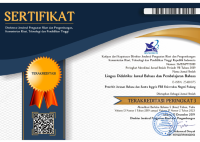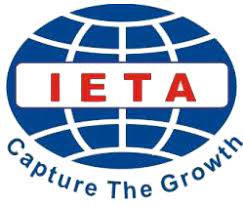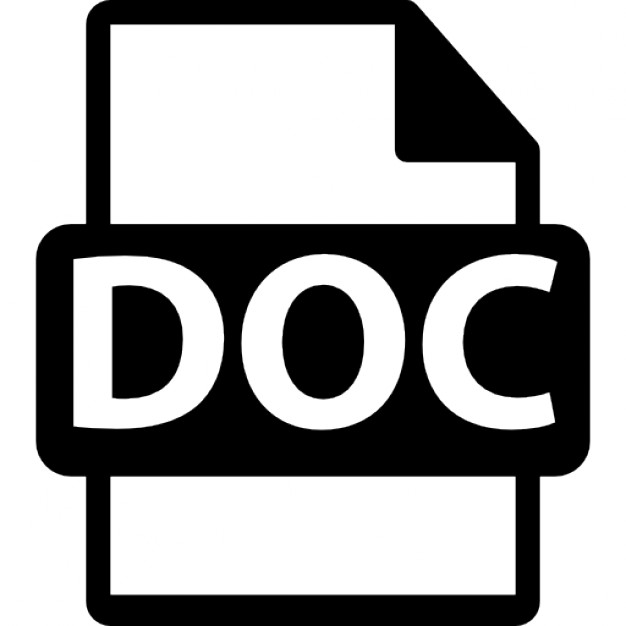Am I a Technophile? the Narrative Study of Teachers’ Belief about Digital Literacy
 ), Nur Arifah Drajati(2), Ngadiso Ngadiso(3),
), Nur Arifah Drajati(2), Ngadiso Ngadiso(3), (1) Sebelas Maret University
(2) Sebelas Maret University
(3) Sebelas Maret University
 Corresponding Author
Corresponding Author
Copyright (c) 2020 Lingua Didaktika: Jurnal Bahasa dan Pembelajaran Bahasa
DOI : https://doi.org/10.24036/ld.v14i1.106724
Full Text:
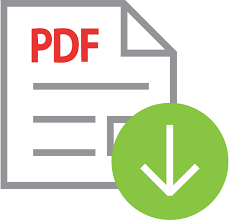 Language : en
Language : en
Abstract
Keywords
References
Albion, P., & Ertmer, P. A. (2002). Beyond the foundations: The role of vision and belief in teachers’ preparation for integration of technology. TechTrends, 46(5), 34–38.
Asuman Aşık, Serhan Köse, Gonca Yangın Ekşi, Gölge Seferoğlu, Ricardo Pereira & Malgorzata Ekiert. (2019). ICT integration in English language teacher education: insights from Turkey, Portugal and Poland. Computer Assisted Language Learning, DOI: 10.1080/09588221.2019.1588744
Atsoglou, K., & Jimoyiannis, A. (2012). Teachers’ decisions to use ICT in classroom practice: An investigation based on decomposed theory of planned behavior. International Journal of Digital Literacy and Digital Competence, 3(2), 20–37.
Barkhuizen, G., Benson, P., & Chik, A. (2014). Narrative inquiry in language teaching and learning research. New York, NY: Routledge.
Borg, S. (2003). Teacher cognition in language teaching: a review of research on what language teachers think, know, believe and do. Language Teaching, 36, 81–109.
Calvani, A., Fini, A., Ranieri, M., & Picci, P. (2012). Are young generations in secondary school digitally competent? A study on Italian teenagers. Computers and Education, 58, 797–807.
Corbel, C., & Gruba, P. (2004). Teaching computer literacy, Teaching with new technology. Sydney: NCELTR.
Cote, T., & Milliner, B. (2018). A survey of EFL teachers digital literacy: A report from a Japanese university. The Journal of Teaching English with Technology, 18(4), 71-89.
D., Wong, A., & Gao, P. (2009). Student teachers’ intentions and actions on integrating technology into their classrooms during student teaching: A Singapore study. Journal of Research on Technology in Education, 42(2), 175–195.
Dashtestani, R. (2014). Computer literacy of Iranian teachers of English as a foreign language: Challenges and obstacles. International Journal of Pedagogies and Learning, 9(1), 87–100.doi:10.1080/18334105.2014.11082022
Dudeney, G., Hockly, N., & Pegrum, M. (2013). Digital literacies. Harlow: Pearson.
Ertmer, P. A., & Ottenbreit-Leftwich, A. T. (2010). Teacher technology change: How knowledge, beliefs, and culture intersect. Journal of Research on Technology in Education, 42(3), 255–284.
Harris, K. (2015). Integrating digital literacy into English language instruction (Issue Brief). Washington, DC: U.S. Department of Education, Office of Career, Technical and Adult Education. Retrieved from https://lincs.ed.gov/programs/eslpro
Healey, D., Hegelheimer, V. H., Hubbard, P., Ioannou, S., Kessler, G., & Ware, P. (2008). TESOL Technology Standards Framework. Alexandria, VA: TESOL.
Hervey, L. G. (2015). Between the notion and the act: Veteran teachers’ TPACK and practice in 1: 1 settings. In C. Angeli & N. Valanides (Eds.), Technological pedagogical content knowledge (pp. 165–189). New York: Springer.
Hew, K. F., & Brush, T. (2007). Integrating technology in K–12 teaching and learning: Current knowledge gaps and recommendations for future research. Educational Technology Research and Development, 55, 223–252.
Hilton, J. T., & Canciello, J. (2013). Tablet English: Student perceptions of an iPad-based digital literacy curriculum. International Journal of Digital Literacy and Digital Competence, 4(4), 1– 14.
Hockly, N. (2011). Digital literacies. ELT Journal, 66(1), 108–112.doi:10.1093/elt/ccr077
Hsu, P.-S. (2016). Examining Current Beliefs, Practices and Barriers About Technology Integration: A Case Study. TechTrends, 60(1), 30–40.
Hutchison, A., & Reinking, D. (2011). Teachers’ perceptions of integrating information and communication technologies into literacy instruction: A National Survey in the U.S. Reading Research Quarterly, 46(4), 308–329
Kagan, D. M. (1992). Implications of research on teacher belief. Educational Psychologist, 27, 65-90.
Lam, Y. (2000). Technophilia vs. Technophobia: A Preliminary Look at Why Second-Language Teachers Do or Do Not Use Technology in Their Classrooms. Canadian Modern Language Review, 56(3), 389–420. doi:10.3138/cmlr.56.3.389
Lee, S. (2014). Digital literacy education for the development of digital literacy. International Journal of Digital Literacy and Digital Competence, 5(3), 29–43.
Liu, H., Lin, C.-H., Zhang, D., & Zheng, B. (2017). Chinese Language Teachers’ Perceptions of Technology and Instructional Use of Technology: A Path Analysis. Journal of Educational Computing Research, 56(3), 396–414.
Magen-Nagar, N., & Firstater, E. (2019). The Obstacles to ICT Implementation in the Kindergarten Environment: Kindergarten Teachers’ Beliefs. Journal of Research in Childhood Education, 1–15.
Magen-Nagar, N., & Shamir, T. (2017). Evaluating the contribution of the national ICT plan to promote the work of teachers. Dapim, 64, 78–110. Hebrew.
Martin, A. (2005). DigEuLit—A European framework for digital literacy: A progress report. Journal of eLiteracy, 2(2), 130–136.
Martin, B. (2018). Faculty technology beliefs and practices in teacher preparation through a TPaCK lens. Education and Information Technologies, 23(5), 1775–1788. doi:10.1007/s10639-017-9680-4
Naghmeh Nazari, Zohreh Nafissi, Masoomeh Estaji & S. Susan Marandi | Shuyan Wang (Reviewing editor). (2019). Evaluating novice and experienced EFL teachers’ perceived TPACK for their professional development, Cogent Education, 6:1
O’Neal, L. J., Gibson, P., & Cotten, S. R. (2017). Elementary School Teachers’ Beliefs about the Role of Technology in 21st-Century Teaching and Learning. Computers in the Schools, 34(3), 192–206.
Petko, D. (2012). Teachers' pedagogical beliefs and their use of digital media in classrooms: Sharpening the focus of the “will, skill, tool” model and integrating teachers' constructivist orientations. Computers & Education, 58(4), 1351e1359. http://dx.doi.org/10.1016/j.compedu.2011.12.013.
R. Hall, L. Atkins, J. Fraser. (2014). Defining a self-evaluation digital literacy framework for secondary educators: the DigiLit Leicester project Research in Learning Technology, 22 (21440) (2014), 10.3402/rlt.v22.21440 Retrieved from http://www.researchinlearningtechnology.net/index.php/rlt/article/view/21440
Sadaf, A., & Johnson, B. L. (2017). Teachers’ beliefs about integrating digital literacy into classroom practice: An investigation based on the theory of planned behavior. Journal of Digital Learning in Teacher Education, 33(4), 129-137
Smarkola, C. (2008). Efficacy of a planned behaviour model: Beliefs that contribute to computer usage intentions of student teachers and experienced teachers. Computers in Human Behavior, 24(3), 1196–1215.
Son, J.-B., Robb, T., & Charismiadji, I. (2011). Computer literacy and competency: A survey of Indonesian teachers of English as a foreign language. CALL-EJ, 12(1), 26–42.
Spires, H., & Bartlett, M. (2012). Digital literacies and learning: Designing a path forward. Friday Institute White Paper Series. NC State University.
Sugar, W., Crawley, F., & Fine, B. (2004). Examining teachers’ decisions to adopt new technology. Educational Technology and Society, 7(4), 201–213.
Voogt, J., Knezek, G., Cox, M., Knezek, D., & ten Brummelhuis, A. (2013). Under which conditions does ICT have a positive effect on teaching and learning? A call to action. Journal of Computer Assisted learning, 29(1), 4–14.
Wright, V., & Wilson, E. (2006). From preservice to inservice teaching: A study of technology integration. Journal of Computing in Teacher Education, 22(2), 49–55.
Yang, S. C., & Huang, Y.-F. (2008). A study of high school English teachers’ behavior, concerns and beliefs in integrating information technology into English instruction. Computers in Human Behavior, 24(3), 1085–1103
 Article Metrics
Article Metrics
 Abstract Views : 739 times
Abstract Views : 739 times
 PDF Downloaded : 197 times
PDF Downloaded : 197 times
Refbacks
- There are currently no refbacks.
Copyright (c) 2020 Lingua Didaktika: Jurnal Bahasa dan Pembelajaran Bahasa

This work is licensed under a Creative Commons Attribution-NonCommercial 4.0 International License.

